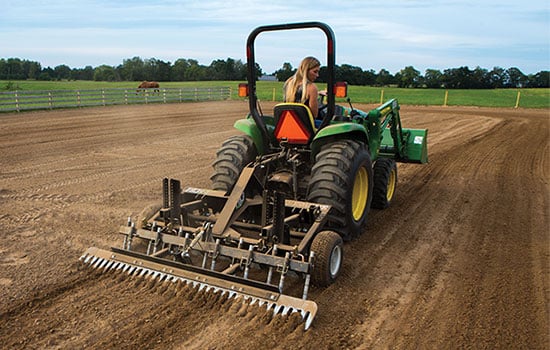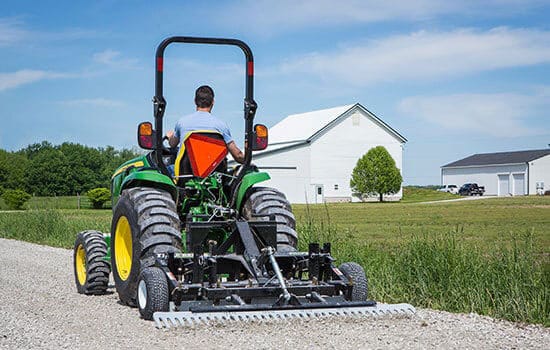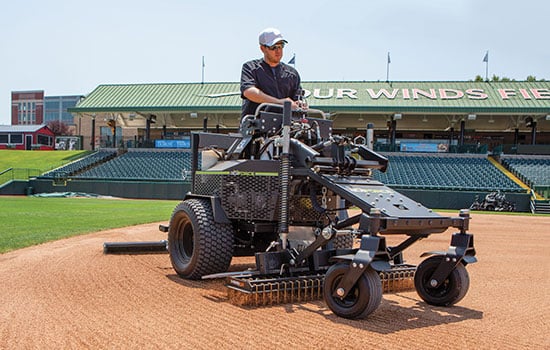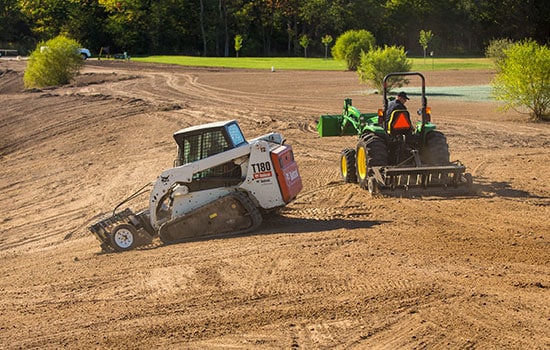Tractor Food Plot Disc at Work! New Option for your TR3 – ABI Dirt
ABI Products Shown In This Video
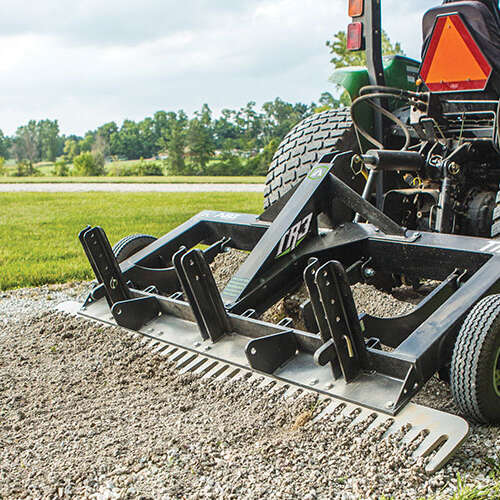
TR3 Rake
- For Compact & Utility Tractors
- 6.5', 7.5', 8.5', 10' Widths - Commercial-Duty
- Starting At: $116/mo.*
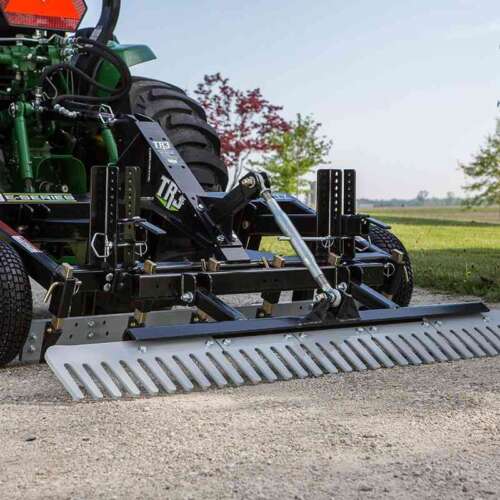
Transcript
Hi everyone, Matt here with ABI attachments. Welcome back to another episode of ABI dirt. We are back at South Farm again today working up two more food plots with both our TR3 and our TR3 E Series. And we wanted to stop before we left the property today, so we can give you a look at the food plot disc, and we want to be able to walk you through the process of kind of the project we were working on, the scope of it. And then the steps we took to use the food plot disc on these two platforms to work it up.
So we’ll start with our rundown on this TR3 E series. This E series is a property addition and it’s a seven foot model. So it can house six scarifiers. But what we’re looking at specifically today are the food plot disc here up front. I’ve taken off this gauge wheel off the sides to get a better look at the food plot disc. What we had to work with today was a field that was planted to rye as a cover crop last fall. And actually they ran out of rye seed toward the end of the project. And so we were down at the bottom of a hill.
I had some sandy sandy loam material and where we had some rye that was coming up about four inches, five inches or so, and then also just some bare soil that was disked up last fall. So we had a combination of live vegetation, rye vegetation there as well as some old corn stocks from last fall. So we opted for just four discs. We could have put in all the way out to six but didn’t think that was quite necessary today. So we’ve put four of our food plot disc here on this E series to start out with. Again, the first couple of passes we just wanted to rip as deep as we could. So we angled the entire rake nose forward. Let these discs really do the muscle of the work.
Those were able to sink down about six inches in all the way up to the hub on these individual spindles here. So we got a nice deep rip that sandy loam material turned really well for us. The rye didn’t even pose a problem at all as far as vegetation getting caught up through the system. So everything was cut up very nicely. Got the depth that we wanted to actually run into traction problems because we had such deep rip out there. So we decided to dial it back thought that was deep enough of a rip. We finished off then, our process, by angling the TR3E series kind of tailed down a little bit. So we could engage. We still have these discs in upfront but they weren’t getting nearly as deep since we’ve got the angle of our tool more angled to the rear. Scarifiers were in play. That gave us some vertical agitation.
And then we wanted to get that finished rake down in place so that the finished rake could a, pull a little bit of material and that leveled out some of our troughs and our furrows there, but also so it could break up any clods across the surface. So we were able to claim some debris, some old corn stocks that came out and we claimed some debris on the scarifiers that didn’t pose a problem for us because we had enough space there. We could lift up the E series, drop some debris piles and just scoop that off into the woods. So we were able to claim some of that old debris, but by and large we had great flow. Evened out the clods. It was a really nice, smooth finish. I had about an inch shaft two inches of really nice loose material on the top which will be ideal for us when we go to throw down the seed. So that’s the process for us on the E series.
Now we’re over here on our TR3 with food plot discs Right away you can tell that on the TR3 the food plot discs that are mounted to individual spindles and shanks fit up into the scarifier pockets on the TR3. Whereas you saw previously on that TR3 E series that we’re leveraging that front profile blade bar assembly. So TR3 E series the discs are in the front of the unit into pockets on that front mounted bar here in the TR3 into the scarifier pockets that are already welded directly to the angle iron on the back of the frame.
Now right away, when we jump over to the TR3, you’re gaining depending on what sizes you’re jumping from from the E serious to the TR3. You’re jumping up anywhere between four or five, 600 pound difference on the weight of the frame itself. So again, we’re still only looking at four discs here on this seven and a half foot TR3. But that means there’s that much more weight per contact point. So same as we’ve been talking about comparing these food plot discs on our units to other food plot discs, you may have seen out in the marketplace that the more discs you have the more you’re spreading out the weight of the frame the weight of the tool into multiple contact points. And you’re actually making it more difficult for your discs to penetrate and decompact the soil the way that you want to.
All right, so to talk through the process here, this was a much more aggressive and more fun process to work through to have this big old TR3 with all of the weight back in the setting we were working in because we actually had to cross across a little ravine and cross through a stream and work up in a meadow that had been previously planted for wild flowers. So the owner here at this property had planted some wild flowers back there. Didn’t quite get the growth, the results that he wanted. And so we asked if we could just till it under. So again, we did not mow ahead of time. We did not spray ahead of time. We haven’t been here multiple times to clear the ground on with bigger piece of machinery or a sprays or chemicals.
We decided to see just what the food plot disc could do on this TR3 frame. And we were thrilled with the result. So we were able to wade through and disc through vegetation that was as tall as 24 inches, 36 inches tall. Again, this is an old wildflower meadow. After a couple of passes all of that was knocked down. Any of the root systems that were there were completely chopped up. So we did a full focus on this food plot disc with the rake out of play. Just all we were trying to do was rip that soil up. So we broke up the vegetation. Chopped up all of the root balls that are there. And one of our engineers wants to call this the Vegetation Annihilator. I don’t know if that’s gonna fly, but we just destroyed all of the bigger material there. We just broke it all up.
Because then, what we can do is take out the food plot disc, put our scarifiers. Again that’s the same vertical agitation component that we recommend for a hard pan, for driveways, for gravel work. We were able to put our scarifiers in balanced the tool back out and use the scarifiers in the finished rake to keep loosening that material, but more points of contact, but also use that finished rake to break up the clods, smooth out the surface. We even did some leveling work in there. We pulled up quite a bit, kind of in a big field stones and rocks and some roots that we have to pull off to the side again and get rid of that debris. And we were left with a finished product then that is ready to throw down some seed and press in.
All right, so bonus round here. We happen to have, the owner of this property happened to have a six foot disc harrow. This is an angle iron disc harrow based on the frame being made out of angle iron, right? Want to just take a quick look at this, because this is something that you can find really common in, you know, Rural Kings and TSCs. You can find a lot of these online. Very lightweight. You can see here though, and this is where we do get, a lot of you provide some great feedback and say, “yeah we hear you. You got new food plot disc to mount under those TR3 and TR3 E series platform.” But that’s just four discs. And here on this six foot angle iron disc harrow you’ve got 20 discs. Isn’t that better? Well, it depends on what you’re trying to accomplish.
Because if your row cropping, right? If when you’re putting in a food plot, if you’ve got a long enough space that you just want to make long passes down, and you want two rows of discs so you can push material one way and then push it back another, kind of create the trough and then cover it back up. Then yeah, two layers of discs work great. The problem comes in when you, depending on the material you’ve got, how deep are you able to go? How much vegetation is still out there? Did you mow? Did you spray? How deep are you trying to rip? What are you trying to plant? Because again, what we’ve discovered as I mentioned just a moment ago is that pounds per contact point is the game changer when it comes to really digging through vegetation and getting the decompaction you want.
Furthermore, if you’re out in the back 40, if you’re out in the woods and you don’t have a lot of space to navigate, if you’re working in small sections of properties, small meadows right next to stream banks or river banks, you don’t have the luxury of large passes back and forth. You may be in a confined area where all you can do with your tow vehicle is make tighter circles. And when that’s the case the two rows aren’t of much benefit, And the depth is what really plays in there, and being able to get that with that single row of food plot disc on your on your ABI drag.
Furthermore, two other items to keep in mind if you’re looking at a designated disc harrow. One is a maintenance issue, right? Because you’ve got discs separated by spacers. You’ve got to drop off the entire gang here. You’ve got to drop off the entire row in order to change one blade, if necessary. Whereas we’ve got on our TR3 and our TR3 E series, as well as the the gravel rascal food plot disc that you’re able to drop down individually discs.
The last point of concern is actually the setting. If you’ve got to take a look around a little bit where this disc harrow is sitting. This tool is currently sitting in the land of tools forgotten. And which is typical of your food plot disc, of your designated disc harrow, because this is a, it’s kind of a one trick pony. This is a tool that does one thing fairly well depending on your soil type. And that is to turn material over. But how often do you do that? And do you need this attached to the back of your tractor all day, every day? And is this something that is going to get used regularly? Or do you need something that is more multi-purpose, something that can tackle food plots as well as driveways, as well as equine arenas, if you’ve got horses as well, as well as preparing seed bed for lawns? So that’s why we prefer the multi-use function on that TR3, TR3 E series. That’s why we prefer the food plot disc and why we wanted to make that available to all of you. It’s like having a multi-tool in your pocket that you just added one more tool to your multi-tool. You don’t get to do that very often, and we’re excited to make that offer.
So if you have any questions about the TR3, the TR3 E series and how the food plot disc fits in, give us a call, talk to a factory rep. They’d be happy to talk you through what we can offer with that food plant disc. But more importantly, they can ask a lot of questions about what you’re working on, and how we can help take care of you. So we look forward to hearing from you.
